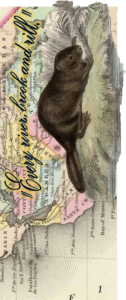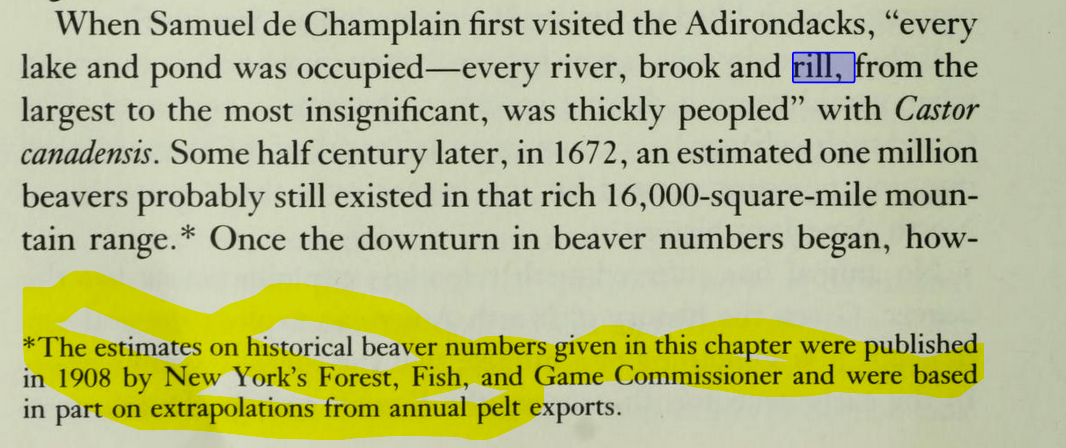 My post on Friday about beavers being in “every river, brook and rill” prompted a lot of discussion and a genuinely knowledgeable comment from Evan the ecohydrologist who asked where it came from and
My post on Friday about beavers being in “every river, brook and rill” prompted a lot of discussion and a genuinely knowledgeable comment from Evan the ecohydrologist who asked where it came from and
“I ask because that exact phase “every river, brook, and rill” was written by Harry Radford in 1907 in reference to the landscape of northern New York State. He presents these as his observations and assumptions, there’s no reason to believe he’s quoting Champlain. See “Eager” by Goldfarb, page 43-44 for a reprint of the Radford quote, or also the original Harry Radford 1907 “History of the Adirondack beaver” quote on page 396 of this citation:
Radford, Harry V. 1907. “History of the Adirondack Beaver: Its Former Abundance, Practical Extermination, and Reintroduction.” Annual Reports of the State of New York Forest, Fish, and Game Commissioner for 1904, 1905, 1906, pp 388–419. https://catalog.hathitrust.org/Record/100349977.
And my initial lightening storm of thoughts went something like this:as “Dam, that guy knows his stuff” and “Oh boy am I stupid I don’t even know who I’m quoting” and then defensively “Jeeze I’m doing my best here and it’s not like I get paid for this or the website costs you anything” and then seamlessly “WOW the website has a long time reader! Someone actually reads this that isn’t related to me!”
Okay, then i put all those thoughts on a shelf to think about later and I went searching through the site to find where I thought the quote came from and I saw articles where I quoted it in 2015 and before that in 2012 and before that in 2010 and before that in 2009! Which I’m sure you’ll agree is very long time ago. November 2009 was the first time it appeared on this website in a post called “Where have all the beavers gone?” which preceeded even our historic papers.
Obviously that was before Ben’s book and before Frances book and before Leila’s book and before I had read much of anything about beavers at all except for Dietland Muller Swarze book which I had browsed on a plane on the way back from a APA conference on assessing family violence in divorce in my old life as a shrink. A LONNNNG time ago.
 So I wandered through the november posts for that year to figure out what I had read that prompted me to write that and I found one aptly called “Revelations” where I was just starting to read Lily Pond by Hope Ryden and was struck by the historical writing she did where she found out that beavers used to enjoy life in the sunshine before the trapping obsession forced them to become nocturnal. Then I looked up her book and found this: on page 46 of Lily Pond to be precise:
So I wandered through the november posts for that year to figure out what I had read that prompted me to write that and I found one aptly called “Revelations” where I was just starting to read Lily Pond by Hope Ryden and was struck by the historical writing she did where she found out that beavers used to enjoy life in the sunshine before the trapping obsession forced them to become nocturnal. Then I looked up her book and found this: on page 46 of Lily Pond to be precise:
 So there it is. Hope was writing about what Samuel De Champlain saw and she used the evocative writing of Henry Radford in the early 1900s who specfically said beavers inhabited every “River Brook and Rill” and was probably translating Samuels words when he said that in 1622 the adirondacks were “peopled” with beaver.
So there it is. Hope was writing about what Samuel De Champlain saw and she used the evocative writing of Henry Radford in the early 1900s who specfically said beavers inhabited every “River Brook and Rill” and was probably translating Samuels words when he said that in 1622 the adirondacks were “peopled” with beaver.
So it was my mistake to combine the two but a fairly understandable one and I could tell exactly why I made it, Hope got interested in the idea because she noticed that beavers didn’t have eyeshine like other nocturnal animals. And when she read up on it she realized that they used to be out in the day and became nocturnal when they were ruthlessly trapped. In fact by 1895 many states reported they no longer had beavers.
“One can speculate that the few animals that escaped this continent-wide decimation must have been the wariest of their kind, deviants, disinclined to build conspicuous lodges. And inded, the late ninteeth-century reports of sightings describe the beaver as a reclusive bank-dweller. One can also speculate that these survivors escaped the notice of trappers by turning night into day, for by the end of the last century, no further mention is made of beavers “sunning themselves on their lodges”.
Hope Ryden: The Lily Pond pg 48
Even though when Samuel De Champlain toured the adirondacks in 1623 there were beaver in every “River, Brook and Rill” according to Harry Radford who described the decimation of beavers three hundred years later.
I’m so happy to finally get it sorted, Thank you Hope, Harry and Evan!






































